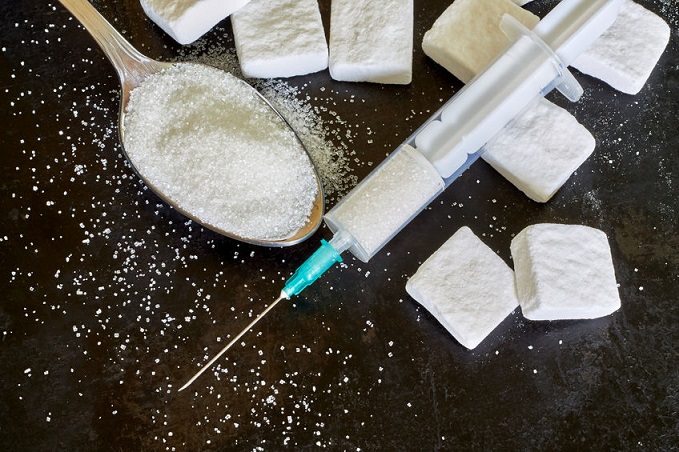 For years, we’ve recommended dozens of dietary acne strategies on this website, ranging from instantaneous to long-range, from the minor to the gamechanging.
For years, we’ve recommended dozens of dietary acne strategies on this website, ranging from instantaneous to long-range, from the minor to the gamechanging.
But what if you can’t implement them? It’s easier said than done to make sweeping changes in long held habits and stick to them religiously. There’s no point being a walking acne encyclopedia if you can’t use the knowledge in your hands. You can’t cure acne without slashing sugar, but some people can’t get through the morning without sugar.
Focus and discipline is undoubtedly a must when dieting. You can play mind games all you want, but ultimately, there aint nothing to it but to do it. But physiology can’t be underestimated either – the real dieting secret lies squarely in the middle.
That’s why it’s finally time we covered the main bodily players in the craving and appetite game. We’ll start with the big cheese – a hormone found in all humans called leptin.
Leptin – your basic fact file
It’s far less famous than testosterone or insulin, but it may be the number one bloodstream difference in people with an unquenchable desire for donuts, despite not being police officers. It’s leptin, and to explain it briefly, leptin is the satiety hormone. It’s the opposite of ghrelin, the hunger hormone.
During starvation, your leptin levels will hit the depths of hunger hell, while after thanksgiving dinner, your leptin will flow freely, making even one more bite of turkey an impossibly difficult chore.
Low leptin is why diets fail, why the lethargy and low mood becomes unbearable. The physical gnawing stomach is one thing, but crawling around the house in a diet-induced funk is another.
Your body enters foraging mode – your hands develop a mind of their own and start picking up food lying around. 10,000 years ago it was a wild berry bush, while today, it’s a pack of cookies lying on the kitchen counter. Leptin unleashes your inner black bear rummaging through a bin.
Leptin is manufactured by fat cells, in response to energy being stored inside them after eating. It binds to transporter proteins, and travels to leptin receptors on the arcuate nucleus of the hypothalamus, the hunger control centre of the brain. The drive to eat will subside, and the energy will come roaring back. It’s not just a raw tidalwave of calories that makes you hyper after a binge – it’s leptin cranking up your metabolic rate.
During hunger, leptin signals the body to enter starvation mode. Low levels slam the breaks on all surplus bodily activity, including libido and motivation to work.
This is rooted in the prehistoric era, as conservation of energy was once a matter of life and death. It’s not like today when you’re sitting your computer chair – starving, but safe from sabre toothed tigers.
After binding to brain receptors, leptin can…
ONE: block anandamide, an appetite-stimulating endocannabinoid created by the brain, with structural similarities to THC in cannabis (a homemade parallel to the munchies).
TWO: block the appetite-stimulating neuropeptide Y, another vital satiety player (which we’ll discuss tomorrow).
THREE: increase a separate appetite suppressant called a-MSH.
In short, low lectin equals ravenous hunger and plentiful lectin equals a satisfied stomach. Leptin is derived from the Greek word for thin – leptos.
Leptin is the subtle player, pressing the buttons of hunger behind the scenes. It doesn’t make your belly rumble, but it does give you that compulsive, yet more elusive form of hunger which is equally powerful. With plentiful lectin in your receptors, a cupcake is a confusing lump of arranged grain dust and buttery goo.
With low leptin, the mere sight instantly brings back happy memories of birthday parties, with the taste at the tip of your tongue. Low leptin is why dieters have elaborate, fantastical dreams about visiting their run down local supermarket, whereas normally, they’d dream about struggling to driving a car with no brakes from the backseat.
The history of leptin
 Leptin was first discovered in a breed of spectacularly obese mice in 1994. More accurately, the mice lacked this satiety hormone, and injecting it into them quenched their appetite and made them thin.
Leptin was first discovered in a breed of spectacularly obese mice in 1994. More accurately, the mice lacked this satiety hormone, and injecting it into them quenched their appetite and made them thin.
In 1995, scientists announced to much excitement that a human form existed. In the late 1990s, a handful of humans were discovered whose leptin production was completely deactivated. One was a 9 year old girl who already weighed 207 pounds. At dinnertime, she devoured platefuls of food in what seemed like seconds. She stashed food away in her bedroom, and had to have liposuction on her legs aged 6 to help her walk.
But when doctors recommended a regular leptin injection course, her appetite plummeted. Within days, she was eating normal 9 year old portions and within months, she was a normal 9 year old girl weight. Elsewhere, a 3 year old child regularly ate up to 2000 calories in a single sitting, but leptin injections slashed this by 80 to 90%.
It seemed simple – the epidemic of obesity across Americans towns and cities was all down to low leptin. Their hunger was a physiological problem as easy to manipulate as vitamin C. The problem was finally solved!
Perhaps the greatest moneymaking opportunity of all time had been created. Pharmaceutical companies glanced at each other, then burst into an all out frenzy to developed the world’s first leptin drug. Of course, this was before they realised that “one weird fruit” from the amazon rainforest melted fat, or that by sprinkling lobster dust on your toast, you can “get a gym body without going to the gym”.
Alas, it was not to be. Studies by the pharmaceutical giant Amgen in 1999 failed miserably. One tested 54 thin people and 73 obese people, with saltwater as a placebo. Leptin only affected 8 people, with 2 losing 35 pounds in eight weeks, but others shedding fewer pounds and one gaining nearly 50. Plus, the injections also cost $500 per day.
The excitement deflated like a balloon. It’s the satiety hormone, so why didn’t injections work? It quickly emerged that despite their ravenous hunger, obese people had dramatically higher leptin levels than thin people. It turned out that the real problem was leptin resistance.
The real leptin problem
It’s similar to prediabetes, when insulin becomes so high that its energy store targets become “insulin resistant”, forcing ever more insulin to be created by the pancreas. Leptin resistance is nearly identical, only with satiety receptors in your brain. The more obese people chronically overeat, the less individual hypothalamus receptors make you feel full when leptin binds to them. This occurs gradually over many years, even decades.
This was why the drug companies’ experiments amounted to nothing. Pouring more leptin into their bloodstream achieved nothing. In fact, it dulled the receptors even more.
It’s another example of how taking us from prehistoric caves and dropping us in high tech cities has messed with a once perfect system. We didn’t have to worry about leptin resistance from mountains of food, because there never was mountains of food.
At first glance, it’s a paradox: obese people have far more satiety hormones coursing through their veins. But the more you eat, the less individual leptin molecules work.
Rather than low leptin, it’s leptin resistance which is behind the 30-40% rates of obesity in the USA as of 2020. Therefore, it’s leptin resistance which you have to fix.
The link to carbohydrates…
 Speaking of which, insulin resistance also has a role. You see, all leptin is stimulated by insulin first.
Speaking of which, insulin resistance also has a role. You see, all leptin is stimulated by insulin first.
Starchy bread digests, glucose rises, insulin spikes to shuttle that glucose away into distant energy stores, and then that insulin signals your fat cells to create leptin. Insulin is the father of the main satiety hormone.
Unfortunately, insulin resistance is also common, with the type 2 diabetes epidemic being the perfect illustration. With ever higher bloodstream insulin, ever greater leptin is created, and ever greater pressure is put on leptin receptors to shrivel up.
Generally, carbohydrates provoke a particularly large leptin spike, whereas protein’s spike is smaller and fat’s is very small.
The insulin spike is one reason, but interestingly, carbohydrate-heavy diets also increase leptin levels regardless of insulin. The modern American food pyramid, with grains at its base (which coincidentally aligns with bulk of the farming industry’s equipment) is packed with carbs. The average American eats 250-300 daily and barely expends them through exercise, except for absentmindedly bouncing a bouncy ball against his wall during office hours.
It’s a nasty cycle to break out of: high carb diets dull your leptin receptors, thus compelling you to eat more carbs. This is why people’s intake creeps upwards imperceptibly over the years, why their frosted flake bowl gets a millimetre deeper each month.
A slightly overweight person would find dieting easier, with a smattering of leptin molecules stimulating receptors which are still decently sensitive. But when obese people cut their food intake and their lectin plummets, possibly for the first time in years, their willpower can’t compete with sudden awakening of primal instinct to eat, eat, eat.
…and the effect on acne
Initially, you were probably over the moon about the clear skin potential of slashing sugar. Then the reality hit you: you’re in a cranky mood, you can’t reach for ice cream to comfort you, and the school bus driver slams the door in your face after shuffling exhaustedly towards it like a zombie.
Thus, your intricately planned acne strategy implodes, because of ancient munching instincts born in the crocodile-dodging expanses of the savannah.
That’s why fixing your satiety hormones is so vital, starting with leptin. After all, it’s your body – they should be on your side! It’s bad enough that everything’s automated, and we can’t just order serotonin to increase by 200%. You don’t want your fullness receptors to shrivel up, making that acne causing donut all the more tempting.
This could be the solution you’re looking for. Maybe your acne-clearing sugar quest always fails like clockwork after 3.5 days. Or maybe you do power through, but it’s so mentally exhausting that you’d love a quick secret hack.
Of course, reducing sugar itself should fix leptin eventually, so the key is to stick at it. To break through that barrier and allow your receptors to normalise again. It’ll be hard, but the long term results will be worth it. You’re setting yourself up for a lifetime of easier diet control, with neurotransmitters doing your bidding, as the lord and master of satiety.
However, there’s also two well-established secondary factors…
A link to chronic inflammation
 It’s the first root cause of acne, an immune system that’s out of control and spraying inflammatory chemicals wherever it pleases, swelling up your skin pores.
It’s the first root cause of acne, an immune system that’s out of control and spraying inflammatory chemicals wherever it pleases, swelling up your skin pores.
One of the classic pro-inflammatory chemicals we discuss here is interleukin-6, whether it’s blueberries or aloe vera reducing it. This chemical targets bacterial infections at the site of a wound. However, IL-6 can also destabilise healthy tissues if unrestrained, so the body dispatches its mirror image, a tracker with a watchful eye – the anti-inflammatory suppressor of cytokine signaling-3 (SOCS-3). The two are released in close cooperation with each other.
If zinc deficiencies have your immune system running wild, or too many omega 6 fatty acids from soybean oil, then SOCS-3 will be higher in your bloodstream. The problem? SOCS-3 acts directly on leptin receptors in the hypothalamus to make them less sensitive. Normally, this is healthy, because after every satiety-giving stimulation, the receptors must be downgraded once your body is calling for energy again. But if SOCS-3 is everywhere due to sky high IL-6, then your leptin receptors will become chronically weak and your appetite will become chronically high. So will your fondness for acne-causing sugars, with cookies gaining a gravitational force that Nobel prize winners scoff at, but you know for sure exists, as you grab the handrail in vain to stop yourself being sucked towards the candy jar.
This causes a feedback loop: more sugar, more chronic inflammation, more leptin resistance, and more sugar. You’re trapped in an acne-causing doom spiral, a whirlwind which only a hard reset can fix, and pressing the mute button whenever those adverts for Farmer Oakmead’s succulent apple pie appear.
Consider this 2009 study. When obese rats were fed SOCS-3 inhibiting drugs, their appetite and weight plummeted rapidly. Knocking out the SOCS-3 genes of obese mice also makes them thinner with astonishing speed (study).
There’s many unanswered questions, but any source of inflammation, whether it’s pesticides, mycotoxins, or omega 6s, could throw a monkey wrench into your appetite machinery.
The sneaky role of lectins
The next section might make your head spin, because another leptin resistance villain is one letter away: lectins.
These are plant toxins found in harmless levels across many foods, like tomatoes and seeds, but high levels in a few. Their main acne danger is leaky gut syndrome, weakening the epithelial cells that control nutrient absorption. They physically glue to your gut lining, wreaking structural havoc when the immune system arrives to destroy them. However, another power is binding to leptin receptors and deactivating them.
One lectin is particularly notorious. Have you ever cleaned up your diet, but reintroduced pizza and bread for a week long holiday to Italy, and noticed your hunger revving up like an F1 car? It’s because of wheat germ agglutinin. This pro-inflammatory villain has the best researched leptin-blocking powers of any lectin, remaining in the receptor for hours.
WGA crosses the brain blood barrier with ease. It’s commonly tested in completely unrelated studies, like observing the distribution of leptin receptors in the brain. Scientists might imbibe wheat germ agglutinin with a mild, harmless radiation, and feed it to volunteers. An X-ray will reveal millions of tiny fluorescent dots, like a city viewed from an aeroplane overhead. However, the mere fact that WGA was such a reliable test substance shows how suspicious wheat is for leptin.
Luckily, scientist are picking up on the threat these days. For example, this 2015 study concluded that “Digested wheat gluten inhibits binding of leptin to the leptin receptor,” with a massive 50% inhibition. The gluten molecules themselves didn’t bind to leptin receptors, so it was probably the WGA inside it. Wheat germ agglutinin occurs in both the germ and the gluten-containing endosperm – the flour making up your pizza.
Consider the “wheat belly” book and movement by William Davis, which details the amazing hunger-reducing experiences of people who have ditched the bread.
The verdict – wheat is dodgy for acne outright, but also makes you eat other dodgy foods, through stealthy hunger manipulation.
The verdict
The sugar fructose is another suspected leptin duller, although the evidence is more inconsistent. More leptin influencing strategies will be uncovered eventually. There’s bound to be antioxidants and nutrients which sensitise the receptors unexpectedly, like resveratrol and magnesium, as completely invented suggestions.
Leptin is an important hormone for every acne patient – it’s probably the best researched satiety player.
Right now, your leptin receptors could be shrinking. It could explain the love hate relationship with pizza and burgers.
The more carbohydrates you eat, the more leptin will rise, and the more carbohydrates you’ll crave. Snap out of this cycle and you’ll regain control over your diet, and by extension, the pimples on your face.
Come back tomorrow, and we will explore the other important satiety substances, including ghrelin and peptide YY.
A final question: if food companies could dump a leptin suppressing gas over New York City via helicopter, do you think they’d do it? I’ll leave it up to you.
Thanks for reading!

Greetings. Not sure if you have ever read the book entitled Eat Wheat by John Douillard? Because he says pretty much the exact opposite of what you write in this article. He says we should boost our digestive powers rather than simply eliminating more and more foods from our diet, and that people who eat wheat have less Alzheimer’s and far lower levels of mercury in the blood. Would be interesting to hear your thoughts on this.